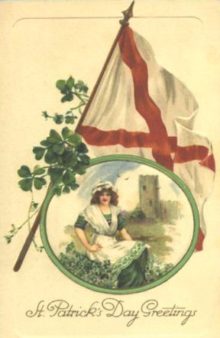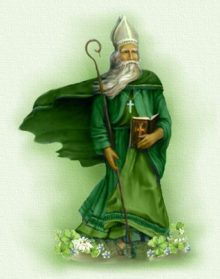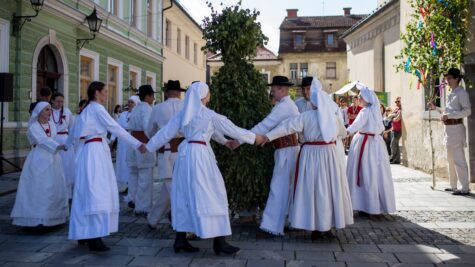Green
Traditionally, on 23/24 April, in areas of Eastern Europe including Romania and Slovenia, people would celebrate ‘Green George’ (also known as ‘Zeleni Jurij’) where a young man would be covered in greenery, often birch and sometimes willow, to recognize the advent of spring and the springing of new life.
Celebrations would traditionally often center around a willow tree from which blessings, healings and protections were invoked.
In days gone by, Zeleni Jurij was celebrated differently in various parts of the region, but what the celebrations had in common was the persona of Zeleni Jurij himself: A young man covered entirely in birch branches, often additionally decorated with colored ribbons.
In some places, Zeleni Jurij went from house to house collecting money. Elsewhere, he rode to town on a white horse. In Črnomelj, Zeleni Jurij was paraded through the streets by singing young people who used ancient Slavic verses to interrogate this ancient harbinger of spring.
At the conclusion of the ceremony, Zeleni Jurij – or at least his arboreal covering – was ceremonially thrown into the Lahinja River.
Whatever the details, the celebrations served as an important rite of spring. According to tradition, Zeleni Jurij spent the winter in the cold, dark underworld, and emerged in the springtime to bring warmth and fertility to the land — and mark the final departure of winter.
Zeleni Jurij has its origins in Slavic mythology, but with the arrival of Christianity, the celebrations merged with the mythology of St. George, a Christian martyr also associated with fertility. The pagan-Christian blend was not unusual, since early Christian missionaries often accepted elements of pagan beliefs only to combine them with Christian teaching. It was due to this Christian influence that Zeleni Jurij was eventually celebrated on St. George’s Day in April.
Because of increased communication and changing rural lifestyles, Zeleni Jurij celebrations began to disappear in the modern area, and most were gone by the early 20th century. In recent years, however, local enthusiasts have made an effort to preserve this part of Slovenia’s national heritage.
Each spring, the Slovenian President formally receives Zeleni Jurij and his entourage of young people. And each June, the town of Črnomelj organizes a Zeleni Jurij procession, bringing to life a rite of spring largely unchanged since the time when the Slavs first arrived in modern-day Slovenia.
Source: Slovenia Revealed
March 17 commemorates Saint Patrick, the patron saint and national apostle of Ireland, and the arrival of Christianity in Ireland. In addition, this day also celebrates the heritage and culture of the Irish in general.
Celebrations generally involve public parades and festivals, céilithe (Irish traditional music sessions), and the wearing of green attire or shamrocks. There are also formal gatherings such as banquets and dances, although these were more common in the past. St Patrick’s Day parades began in North America in the 18th century but did not spread to Ireland until the 20th century.
The participants generally include marching bands, the military, fire brigades, cultural organisations, charitable organisations, voluntary associations, youth groups, fraternities, and so on. However, over time, many of the parades have become more akin to a carnival. More effort is made to use the Irish language; especially in Ireland, where the week of St Patrick’s Day is “Irish language week”. Recently, famous landmarks have been lit up in green on St Patrick’s Day.
Christians also attend church services and the Lenten restrictions on eating and drinking alcohol are lifted for the day. Perhaps because of this, drinking alcohol – particularly Irish whiskey, beer or cider – has become an integral part of the celebrations.
The St Patrick’s Day custom of ‘drowning the shamrock‘ or ‘wetting the shamrock‘ was historically popular, especially in Ireland. At the end of the celebrations, shamrock is put into the bottom of a cup, which is then filled with whiskey, beer or cider. It is then drank as a toast; to St Patrick, to Ireland, or to those present. The shamrock would either be swallowed with the drink, or be taken out and tossed over the shoulder for good luck.
In every household the herb is placed upon the breakfast table of the master and the mistress, who “drown the shamrock” in generous draughts of whiskey, and then send the bottle down into the kitchen for the servants.
 On St Patrick’s Day it is customary to wear shamrocks and/or green clothing or accessories (the “wearing of the green”). St Patrick is said to have used the shamrock, a three-leaved plant, to explain the Holy Trinity to the pagan Irish. This story first appears in writing in 1726, though it may be older.
On St Patrick’s Day it is customary to wear shamrocks and/or green clothing or accessories (the “wearing of the green”). St Patrick is said to have used the shamrock, a three-leaved plant, to explain the Holy Trinity to the pagan Irish. This story first appears in writing in 1726, though it may be older.
Long before the shamrock became associated with St. Patrick’s Day, the four-leaf clover was regarded by ancient Celts as a charm against evil spirits.
In pagan Ireland, three was a significant number and the Irish had many triple deities, a fact that may have aided St Patrick in his evangelisation efforts. Patricia Monaghan says there is no evidence that the shamrock was sacred to the pagan Irish. However, Jack Santino speculates that it may have represented the regenerative powers of nature, and was recast in a Christian context—icons of St Patrick often depict the saint “with a cross in one hand and a sprig of shamrocks in the other”. Roger Homan writes, “We can perhaps see St Patrick drawing upon the visual concept of the triskele when he uses the shamrock to explain the Trinity”.
In the early 1900’s, O. H. Benson, an Iowa school superintendent, came up with the idea of using a clover as the emblem for a newly founded agricultural club for children in his area. In 1911, the four-leaf clover was chosen as the emblem for the national club program, later named 4-H.
The color green has been associated with Ireland since at least the 1640’s, when the green harp flag was used by the Irish Catholic Confederation. Green ribbons and shamrocks have been worn on St Patrick’s Day since at least the 1680s. The Friendly Brothers of St Patrick, an Irish fraternity founded in about 1750, adopted green as its color.
However, when the Order of St. Patrick—an Anglo-Irish chivalric order—was founded in 1783 it adopted blue as its color, which led to blue being associated with St Patrick. During the 1790’s, green would become associated with Irish nationalism, due to its use by the United Irishmen. This was a republican organisation—led mostly by Protestants but with many Catholic members—who launched a rebellion in 1798 against British rule.
The phrase “wearing of the green” comes from a song of the same name, which laments United Irishmen supporters being persecuted for wearing green. Throughout the 19th and 20th centuries, the color green and its association with St Patrick’s Day grew.
The wearing of the ‘St Patrick’s Day Cross’ was also a popular custom in Ireland until the early 20th century. These were a Celtic Christian cross made of paper that was “covered with silk or ribbon of different colors, and a bunch or rosette of green silk in the center”.
The most popular of the many legends about St. Patrick is the one which credits him for having driven all the snakes and vermin out of Ireland.
Here’s an old old poem about it:
There’s not a mile in Ireland’s isle
where the dirty vermin musters;
Where’er he put his dear forefoot
he murdered them in clusters.
The toads went hop, the frogs went flop,
slap dash into the water,
And the beasts committed suicide to
save themselves from slaughter.
Nine hundred thousand vipers blue
he charmed with sweet discourses.
And dined on them at Killaloo
in soups and second courses.
When blindworms crawling on the grass
disgusted all the nation,
He gave them a rise and opened their eyes
to a sense of the situation.
The Wicklow Hills are very high, and
so’s the Hill of Howth, sir;
But there’s a hill much higher still—ay,
higher than them both, sir;
‘Twas on the top of this high hill St.
Patrick preached the sarmint
That drove the frogs into the bogs and
bothered all the varmint.
About St Patrick
 Patrick was a 5th-century Romano-British Christian missionary and bishop in Ireland. Much of what is known about Saint Patrick comes from the Declaration, which was allegedly written by Patrick himself. It is believed that he was born in Roman Britain in the fourth century, into a wealthy Romano-British family. His father was a deacon and his grandfather was a priest in the Christian church.
Patrick was a 5th-century Romano-British Christian missionary and bishop in Ireland. Much of what is known about Saint Patrick comes from the Declaration, which was allegedly written by Patrick himself. It is believed that he was born in Roman Britain in the fourth century, into a wealthy Romano-British family. His father was a deacon and his grandfather was a priest in the Christian church.
According to the Declaration, at the age of sixteen, he was kidnapped by Irish raiders and taken as a slave to Gaelic Ireland. ] It says that he spent six years there working as a shepherd and that during this time he “found God”. The Declaration says that God told Patrick to flee to the coast, where a ship would be waiting to take him home. After making his way home, Patrick went on to become a priest.
According to tradition, Patrick returned to Ireland to convert the pagan Irish to Christianity. The Declaration says that he spent many years evangelising in the northern half of Ireland and converted “thousands”. Patrick’s efforts against the druids were eventually turned into an allegory in which he drove “snakes” out of Ireland (Ireland never had any snakes).
Tradition holds that he died on 17 March and was buried at Downpatrick. Over the following centuries, many legends grew up around Patrick and he became Ireland’s foremost saint.
NOTE:
What many people don’t realize is that the serpent was actually a metaphor for the early Pagan faiths of Ireland. St. Patrick brought Christianity to the Emerald Isle, and did such a good job of it that he practically eliminated Paganism from the country. Because of this, some modern Pagans refuse to observe a day which honors the elimination of the old religion in favor of a new one. It’s not uncommon to see Pagans and Wiccans wearing some sort of snake symbol on St. Patrick’s Day, instead of those green “Kiss Me I’m Irish” badges.
Sources: Almanac.com, Wikipedia, and Encyclopaedia of Superstitions, Folklore, and the Occult Sciences






